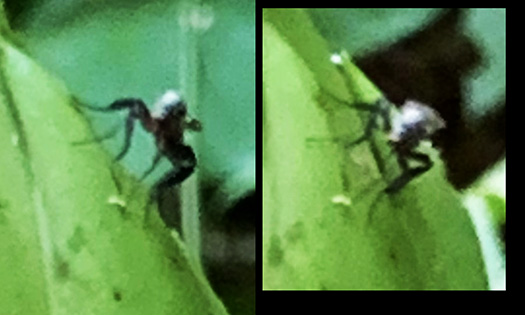


わたしのブログの本籍は住宅取材周辺地。なんですが、
やはりいろいろストレスも溜まるので、それ以外のテーマも書く。
というなかで、オオウバユリの観察は散歩の大きな動機でもあります。
で、オオウバユリは札幌円山自然林のなかで多数自生している。
上の写真のように花芽が膨らんでくると、点々と食害痕跡。
まぁ、多少見栄えはこの時期は悪くなるけれど、
この時期を過ぎて花芽が開花する時期になると気にならなくなる。
自然の輪廻には、いろいろなイキモノの活動も関与することになる。
で、こういう食害の状況とはどういうことなのか、と思っていたら、
このブログの心強い応援者である、札幌在住のNさんから
「オオウバユリの食痕は、たぶんカタクリハムシが犯人ですね。
体長1cmくらいの小豆色の甲虫です。「カタクリ」ハムシという名前ですけど、
カタクリよりユリ科に多くいるような気がします。
それでユリハムシという別称もあります。」という情報。
添付されていた写真が3枚目であります。
そんなことかと情報に感謝していましたが、
偶然にiPhoneでオオウバユリ撮影中にどうもそれらしき羽虫を見かけた。
上の写真の右上に忽然と出現している。
思いがけない事態に動転しつつ、もっと鮮明にと思ってシャッターを。
さらに角度を変えて個体特定をと考えたのですが、あえなくそこで飛翔。
残ったのは2枚の証拠写真。
やや不鮮明で角度も違うので完全にこのカタクリハムシなのかどうか、
確定はできませんでした。
しかしこういう機会が巡ってきたことだけでも奇跡的。
NHKの自然観察ドキュメンタリー撮影でもない、素人の撮影では
まことにあり得ないくらいの偶然の成せる技。
北の地で自然の夏の輪廻はことしも元気に繰り返されていることを実感。
見方によっては「気持ち悪い」と思われる方もいるかも、ですが、
しかしイキモノの必死に生きる様はまさに自然のいとなみ。
オオウバユリにとっては天敵なのかもですが、
この羽虫もまた、自然の貴重な一部であり輪廻連鎖のワンパート。
ヒグマの出没のような人間界への直接的脅威には対応すべきですが
そうでない場合には人間は自制的に観察に徹するべきでしょうね。
English version⬇
[Are you identifying the criminal who eats cardiocrinum? ]
The registered domicile of my blog is the area around the housing coverage. What is it?
After all, various stresses accumulate, so I will write other themes as well.
Observing the cardiocrinum cordifolia is also a major motivation for taking a walk.
So, many cardiocrinum cordifolia grow naturally in the Maruyama natural forest in Sapporo.
When the flower buds swell as shown in the photo above, there are traces of feeding damage.
Well, it looks a little worse at this time of year,
After this time, when the flower buds bloom, it doesn’t bother me.
Various activities of living things will be involved in the reincarnation of nature.
So, when I was wondering what this kind of feeding damage was like,
From Mr. N, who lives in Sapporo, who is a reassuring supporter of this blog
“Maybe the leaf beetle is the culprit in the food marks of Cardiocrinum cordifolia.
It is a russet-colored beetle with a body length of about 1 cm. The name is “Katakuri” leaf beetle,
I feel that there are more in the lily family than in the erythronium.
Therefore, there is another name called Yurihamushi. Information.
The attached photo is the third one.
I was grateful for the information, but
I happened to see those feather bugs while shooting Cardiocrinum cordatum on my iPhone.
It suddenly appears in the upper right of the above photo.
While being upset by an unexpected situation, I thought it would be clearer and released the shutter.
I thought about identifying the individual by changing the angle further, but I flew there for the time being.
There are two evidence photos left.
It’s a little unclear and the angle is different, so I wonder if it’s completely this leaf beetle.
It could not be confirmed.
However, it is miraculous just to have such an opportunity.
Not in NHK’s nature observation documentary shooting, but in amateur shooting
A technique that can be done by chance, which is impossible.
I realized that the natural summer reincarnation is being repeated vigorously in the northern part of the country.
Some people may think that it is “unpleasant” depending on the viewpoint, but
However, the desperate life of a living thing is just like a natural cousin.
It may be a natural enemy for Oobayuri,
This feather bug is also a precious part of nature and a part of the reincarnation chain.
We should respond to direct threats to the human world, such as the infestation of brown bears.
If this is not the case, humans should be self-restraint in their observations.
Posted on 7月 4th, 2021 by 三木 奎吾
Filed under: こちら発行人です, 日本社会・文化研究







コメントを投稿
「※誹謗中傷や、悪意のある書き込み、営利目的などのコメントを防ぐために、投稿された全てのコメントは一時的に保留されますのでご了承ください。」
You must be logged in to post a comment.